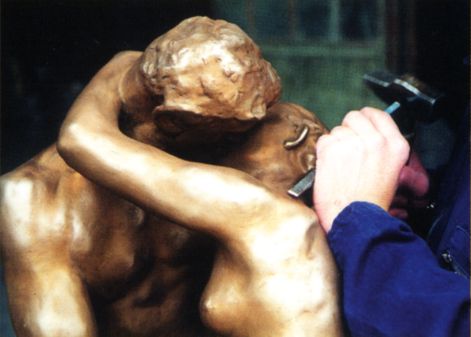H. de Roos - What is an original Rodin? |
|
|
With regard to bronze casting, we should acknowledge that every bronze cast per se is the result of multiplication. Rodinīs starting point was the clay model. As long as the clay model was unfinished, it was kept wet, so that the clay would not crack. An when the model was ready, it was reproduced to create an "original plaster" or impression. In this process, the original clay model was destroyed. In the creux perdu process, the moulds used to produce the plaster were destroyed as well; they had to be broken open in order to remove the impression. In the bon creux process, the mould was composed of several pieces fitting together and could be used many times again to produce more plasters. |
|
|
So the plaster and the bon creux moulds replace the original clay model and become the starting point for a chain of multiplication. This chain - from the clay model, the bon creux mould
and the first-generation plaster to the piece mould and the investment
mould and finally to the bronze - is demonstrated in the R.O.M.
exhibition, as well as on www.plaster2bronze.com. |
|
|
Monique Laurent indicates that from 1900 till 1915, Rodin heavily relied on the judgement of his oild friend Jean Limet, who patinated most of the bronzes during this period. The casts were even sent directly from the foundry to Limet, who reported on their quality to Rodin. It should be noted, though, that this procedure was based on "a climate of great confidence, hardly the rule for Rodin, whose collaborators deplored his distrust and changeable humor" [Laurent, in Elsen, p. 292]. Tancock mentions an example of Rodinīs demanding attitude even within his relation to Limet: Rodin was notoriously hard to please when it came to the
finishing of his bronzes. Judith Cladel related that Jean Limet, who
specialized in the patination of bronzes, gave three different patinas to
The Walking Man. (..) before Rodin was satisfied with it. (..) Many
references in the correspondence attest to the fact that it was frequently
the achieving of a rich patina that caused delays in the delivery of works
that were commissioned from him. In the next Chapter, we will see the way Rodin supervised and authorized the execution of his sculptures must be considered in our definitions of an original work.
|
|
